Experimental Investigation of the Improvement Potential of a Heat Pump Equipped with a Two-Phase Ejector
Abstract
:1. Introduction
2. Experimental Setup
2.1. Test Based on the VCHP
2.2. Test Based on the EEHP
2.3. Instrumentations and Data Reduction
3. Results and Discussion
3.1. Performance Comparison of an Ejector–Expansion Heat Pump with a Vapor-Compression Heat Pump
3.1.1. The Impact of Variations in the Heat Sink Temperature
3.1.2. Impact of Variations in the Heat Source Temperature
3.2. Impact of the Expansion Pressure Ratio on the Two-Phase Ejector’s Performance
4. Conclusions
- The EEHP can produce higher QH and COPHP values than the VCHP under a heat sink (TH) between 40 and 60 °C. The percentage improvement is 3.7–11.2% compared to the VCHP (conventional system). A higher percentage improvement is achieved by increasing the TH;
- As the heat source (TL) is increased while the heat sink (TH) is kept constant, the EEHP achieves a higher heating rate and COPHP than the VCHP. The percentage improvement is 6.1–11.6%. A lower heat source temperature yields a higher percentage improvement;
- The key to improving performance is the use of a two-phase ejector. This is because of the pressure lift effect and the mass entrainment performance. Additionally, an increase in the compressor suction pressure via the pressure lift causes the refrigerant density to be increased, which results in a higher mass flow rate (at a fixed compressor rotational speed) through the compressor and condenser. Hence, the EEHP yields a higher heating rate than the VCHP;
- The expansion pressure ratio (the pressure ratio between the heat sink and the heat source) significantly affects the two-phase ejector operations, as indicated by the entrainment performance and the pressure lift ratio;
- There is a trade-off between the pressure lift ratio and the entrainment ratio for a certain expansion pressure ratio. The heating capacity of the EEHP is associated with these parameters, which demonstrate the actual working conditions.
Author Contributions
Funding
Data Availability Statement
Acknowledgments
Conflicts of Interest
Nomenclature
| A | Cross-sectional area (m2) |
| COP | Coefficient of performance |
| EEHP | Ejector–expansion heat pump |
| ER | Entrainment ratio |
| Elec | Electricity consumption |
| h | Refrigerant-specific enthalpy (kJ kg−1) |
| VCHP | Vapor-compression heat pump |
| m | Mass flow rate (kg s−1) |
| P | Pressure (bar) |
| PR | Pressure ratio |
| Q | Heat transfer rate (kW) |
| T | Temperature (°C) |
| Subscripts | |
| chill | Represents chilled water |
| con | Represents the condenser |
| dis-comp | Represents the compressor discharge |
| evap | Represents the evaporator |
| evap-out | Represents the evaporator outlet |
| exit-nozz | Condition at the primary nozzle’s exit |
| expan | Represents the expansion process |
| H | Refers to the heat sink |
| hot | Refers to hot water |
| in-nozz | Inlet nozzle condition |
| L | Refers to the heat source |
| lift | Lift ratio |
| mix | Condition at ejector mixing |
| suc-comp | Condition at compressor suction |
| pri | Represents the primary fluid |
| sec | Represents the secondary fluid |
| t-ej | Ejector mixing chamber throat |
| t-nozz | Primary nozzle throat |
References
- Huang, Z.; Li, T. Experimental Investigation of Gravity Effect on a Vapor Compression Heat Pump System. Energies 2023, 16, 4412. [Google Scholar] [CrossRef]
- Szymiczek, J.; Szczotka, K.; Banaś, M.; Jura, P. Efficiency of a Compressor Heat Pump System in Different Cycle Designs: A Simulation Study for Low-Enthalpy Geothermal Resources. Energies 2022, 15, 5546. [Google Scholar] [CrossRef]
- Zhou, Y.; Peng, B.; Zhu, B. Assessment of Optimal Operating Range and Case Verification of a Waste Heat Air-Source Heat Pump Water Heater Based on a Semiempirical Parametric Model. Energies 2023, 16, 2289. [Google Scholar] [CrossRef]
- Navarro-Esbrí, J.; Mota-Babiloni, A. Experimental analysis of a high temperature heat pump prototype with low global warming potential refrigerant R-1336mzz (Z) for heating production above 155 °C. Int. J. Thermofluids 2023, 17, 100304. [Google Scholar] [CrossRef]
- Trancossi, M.; Cannistraro, G.; Pascoa, J. Thermoelectric and solar heat pump use toward self sufficient buildings: The case of a container house. Therm. Sci. Eng. Prog. 2020, 18, 100509. [Google Scholar] [CrossRef]
- Zanetti, E.; Azzolin, M.; Bortolin, S.; Busato, G.; Del Col, D. Experimental data and modelling of a dual source reversible heat pump equipped with a minichannels evaporator. Therm. Sci. Eng. Prog. 2022, 35, 101471. [Google Scholar] [CrossRef]
- Shiravi, A.H.; Ghanbarpour, M.; Palm, B. Experimental evaluation of the effect of mechanical subcooling on a hydrocarbon heat pump system. Energy 2023, 274, 127406. [Google Scholar] [CrossRef]
- Zhang, Q.; Huang, H.; Zhai, H.; Zhao, W.; Lü, X. Experimental research on direct expansion heat pump flue gas waste heat recovery and humidification nitrogen reduction system. J. Clean. Prod. 2023, 406, 137000. [Google Scholar] [CrossRef]
- Hu, Z.; Li, Y.; El-Mesery, H.S.; Yin, D.; Qin, H.; Ge, F. Design of new heat pump dryer system: A case study in drying characteristics of kelp knots. Case Stud. Therm. Eng. 2022, 32, 101912. [Google Scholar] [CrossRef]
- Yuan, Y.; Hassan, A.; Zhou, J.; Zeng, C.; Yu, M.; Emmanuel, B. Experimental and numerical investigation on a solar direct-expansion heat pump system employing PV/T & solar thermal collector as evaporator. Energy 2022, 254, 124312. [Google Scholar]
- Wang, Y.; Zong, S.; Song, Y.; Cao, F.; He, Y.; Gao, Q. Experimental and techno-economic analysis of transcritical CO2 heat pump water heater with fin-and-tube and microchannel heat exchanger. Appl. Therm. Eng. 2021, 199, 117606. [Google Scholar] [CrossRef]
- Chiriboga, G.; Capelo, S.; Bunces, G.C.; Cepeda, J.; Gordillo, G.; Montesdeoca, D.E. Harnessing of geothermal energy for a greenhouse in Ecuador employing a heat pump: Design, construction, and feasibility assessment. Heliyon 2021, 7, e08608. [Google Scholar] [CrossRef]
- Lim, H.; Kim, C.; Cho, Y.; Kim, M. Energy saving potentials from the application of heat pipes on geothermal heat pump system. Appl. Therm. Eng. 2017, 126, 1191–1198. [Google Scholar] [CrossRef]
- Ye, J.; Ni, L. Experimental study on heating performance of air source heat pump fresh air unit with fresh air and return air mixing in severe cold regions. Energy Build. 2023, 283, 112839. [Google Scholar] [CrossRef]
- Leonzio, G.; Fennell, S.; Shah, N. Air-source heat pumps for water heating at a high temperature: State of the art. Sustain. Energy Technol. Assess. 2022, 54, 102866. [Google Scholar] [CrossRef]
- Wu, J.; Sun, S.; Song, Q.; Wang, D.; Sun, D. Subcritical recuperative air-to-water heat pump with zeotropic mixtures: Comparative and performance assessment. Energy Rep. 2022, 8, 13682–13697. [Google Scholar] [CrossRef]
- Huang, M.J.; Hewitt, N.J. The experimental analysis of the effect of ambient factors on the defrosting of economised vapour injection compressor air source heat pump in marine climates. Int. J. Refrig. 2013, 36, 820–827. [Google Scholar] [CrossRef]
- Li, K.; Ma, J.; Zhang, B.; Su, L.; Liu, N.; Zhang, H.; Dou, B.; He, Q.; Zhou, X.; Tu, R. Experimental study on low temperature heating performance of different vapor injection heat pump systems equipped with a flash tank and economizers for electric vehicle. Appl. Therm. Eng. 2023, 227, 120428. [Google Scholar] [CrossRef]
- Yang, T.; Zou, H.; Tang, M.; Tian, C.; Yan, Y. Experimental performance of a vapor-injection CO2 heat pump system for electric vehicles in −30 °C to 50 °C range. Appl. Therm. Eng. 2022, 217, 119149. [Google Scholar] [CrossRef]
- Li, J.; Fan, Y.; Zhao, X.; Bai, X.; Zhou, J.; Badiei, A.; Myers, S.; Ma, X. Design and analysis of a novel dual source vapor injection heat pump using exhaust and ambient air. Energy Built Environ. 2022, 3, 95–104. [Google Scholar] [CrossRef]
- Boccardi, G.; Botticella, F.; Lillo, G.; Mastrullo, R.; Mauro, A.W.; Trinchieri, R. Experimental investigation on the performance of a transcritical CO2 heat pump with multi-ejector expansion system. Int. J. Refrig. 2017, 82, 389–400. [Google Scholar] [CrossRef]
- Ghazizade-Ahsaee, H.; Askari, I.B. The application of thermoelectric and ejector in a CO2 direct-expansion ground source heat pump; energy and exergy analysis. Energy Convers. Manag. 2020, 226, 113526. [Google Scholar] [CrossRef]
- Zhu, Y.; Huang, Y.; Li, C.; Zhang, F.; Jiang, X. Experimental investigation on the performance of transcritical CO2 ejector–expansion heat pump water heater system. Energy Convers. Manag. 2018, 167, 147–155. [Google Scholar] [CrossRef]
- Zhang, Z.; Feng, X.; Tian, D.; Yang, J.; Chang, L. Progress in ejector-expansion vapor compression refrigeration and heat pump systems. Energy Convers. Manag. 2020, 207, 112529. [Google Scholar] [CrossRef]
- Li, S.; Lu, J.; Li, W.; Huang, S.; Tian, L. Comparative performance of ternary azeotropic mixtures as substitutes for R134a in dual-temperature air source heat pump combined ejector. Therm. Sci. Eng. Prog. 2023, 37, 101577. [Google Scholar] [CrossRef]
- Fan, C.; Yan, G.; Yu, J. Thermodynamic analysis of a modified solar assisted ejector-compression heat pump cycle with zeotropic mixture R290/R600a. Appl. Therm. Eng. 2019, 150, 42–49. [Google Scholar] [CrossRef]
- Al-Sayyab, A.K.S.; Navarro-Esbrí, J.; Mota-Babiloni, A. Energy, exergy, and environmental (3E) analysis of a compound ejector-heat pump with low GWP refrigerants for simultaneous data center cooling and district heating. Int. J. Refrig. 2022, 133, 61–72. [Google Scholar] [CrossRef]
- Sutthivirode, K.; Thongtip, T. Experimental investigation of a two-phase ejector installed into the refrigeration system for performance enhancement. Energy Rep. 2022, 8, 7263–7273. [Google Scholar] [CrossRef]
- Zhang, Y.; Wei, X.; Qin, X. Experimental study on energy, exergy, and exergoeconomic analyses of a novel compression/ejector transcritical CO2 heat pump system with dual heat sources. Energy Convers. Manag. 2022, 271, 116343. [Google Scholar] [CrossRef]
- Nemati, A.; Nami, H.; Yari, M. A comparison of refrigerants in a two-stage ejector-expansion transcritical refrigeration cycle based on exergoeconomic and environmental analysis. Int. J. Refrig. 2017, 84, 139–150. [Google Scholar] [CrossRef]
- Bilir, N.; Ersoy, H.K. Performance improvement of the vapour compression refrigeration cycle by a two-phase constant area ejector. Int. J. Energy Res. 2009, 33, 469–480. [Google Scholar] [CrossRef]
- Ersoy, H.K.; Bilir, N. The influence of ejector component efficiencies on performance of ejector expander refrigeration cycle and exergy analysis. Int. J. Exergy 2010, 7, 425–438. [Google Scholar] [CrossRef]
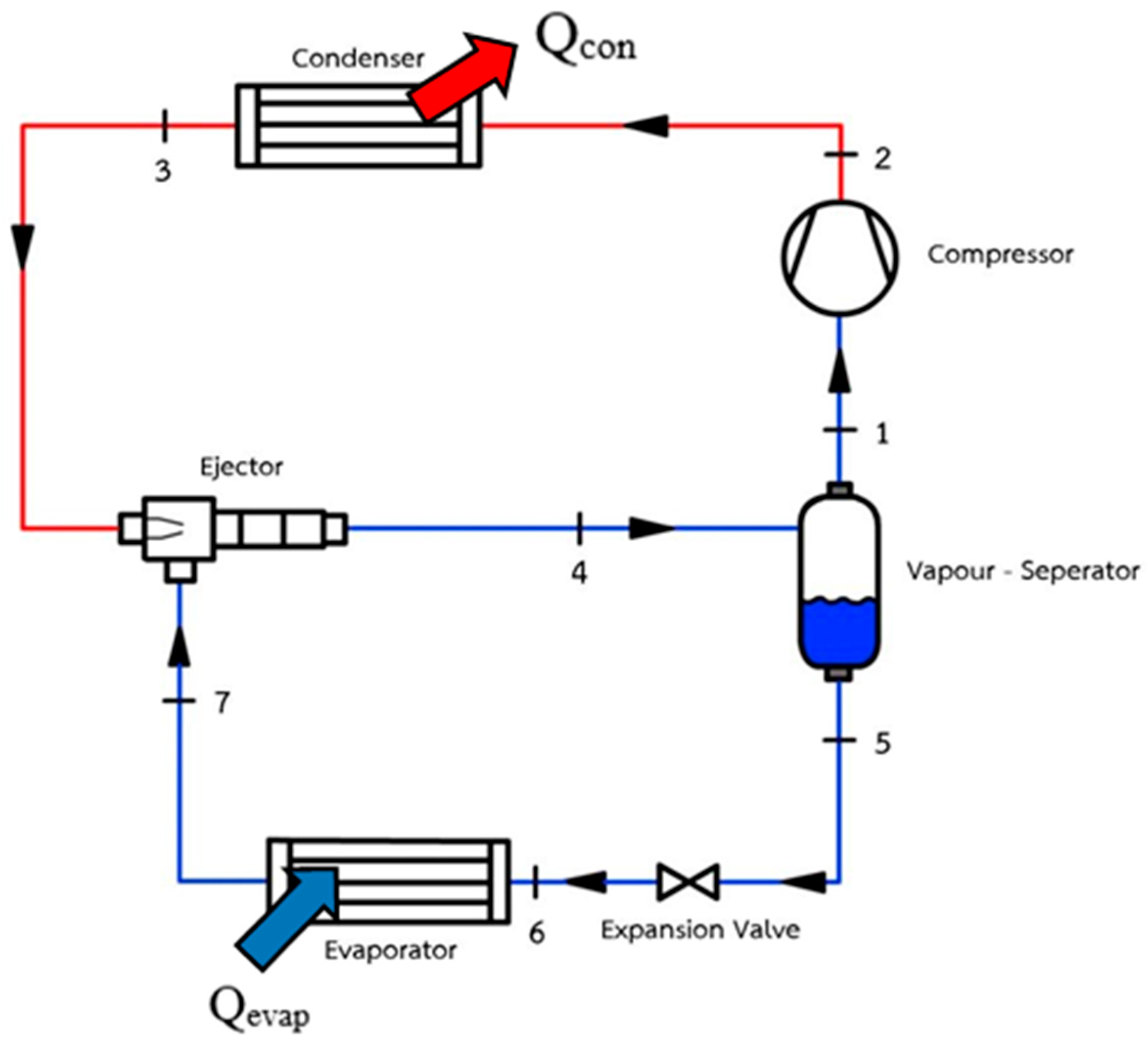

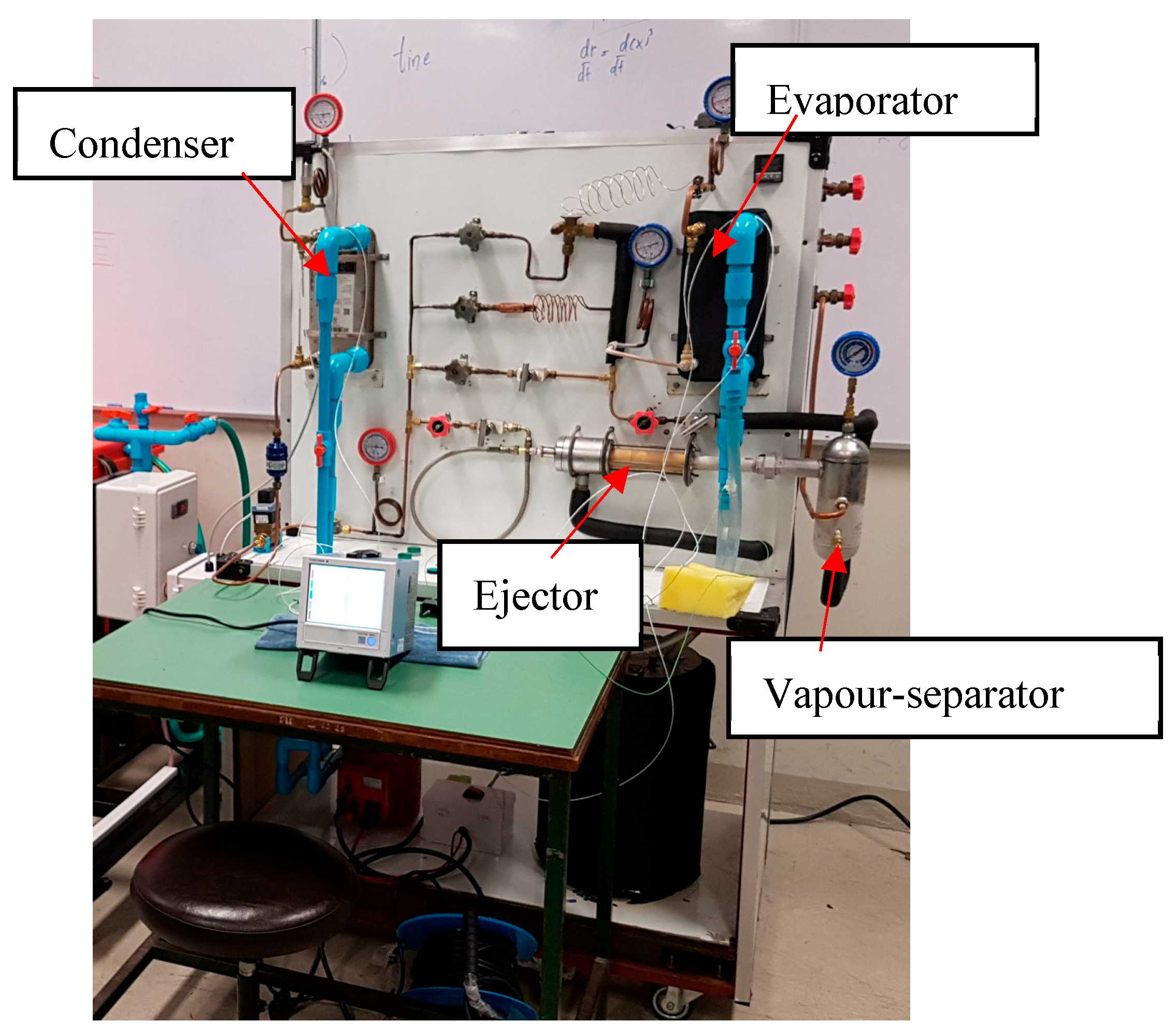

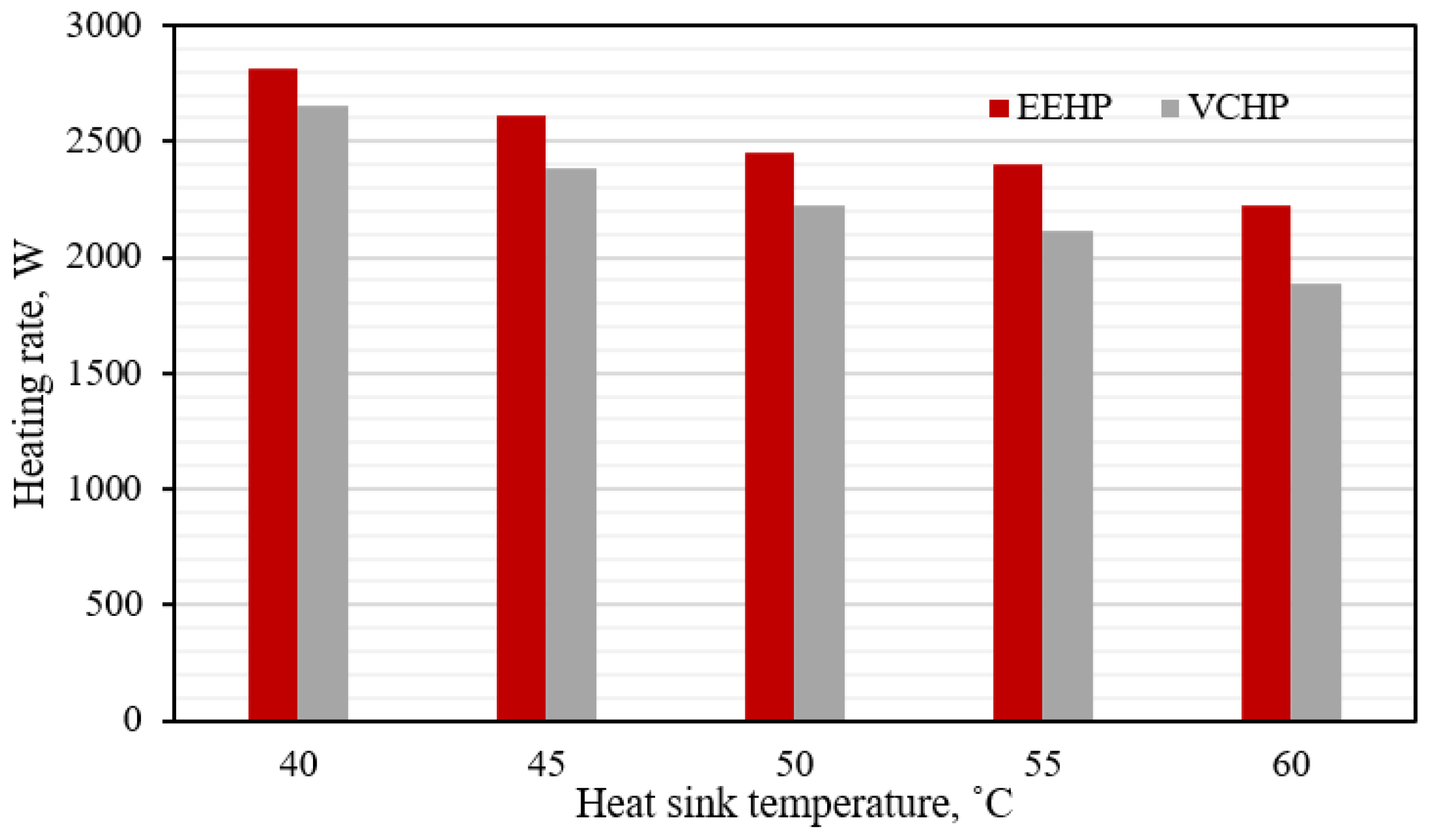
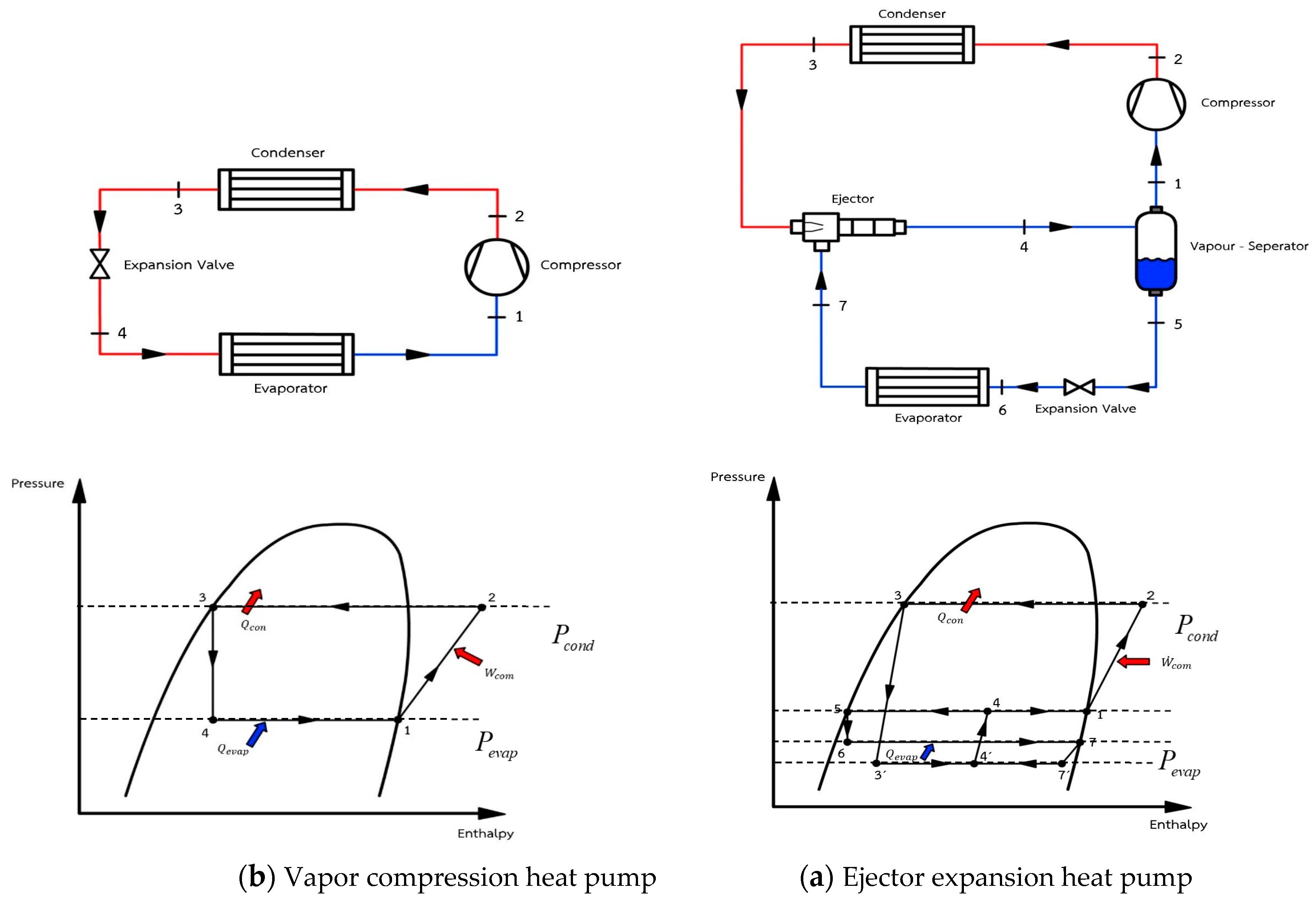

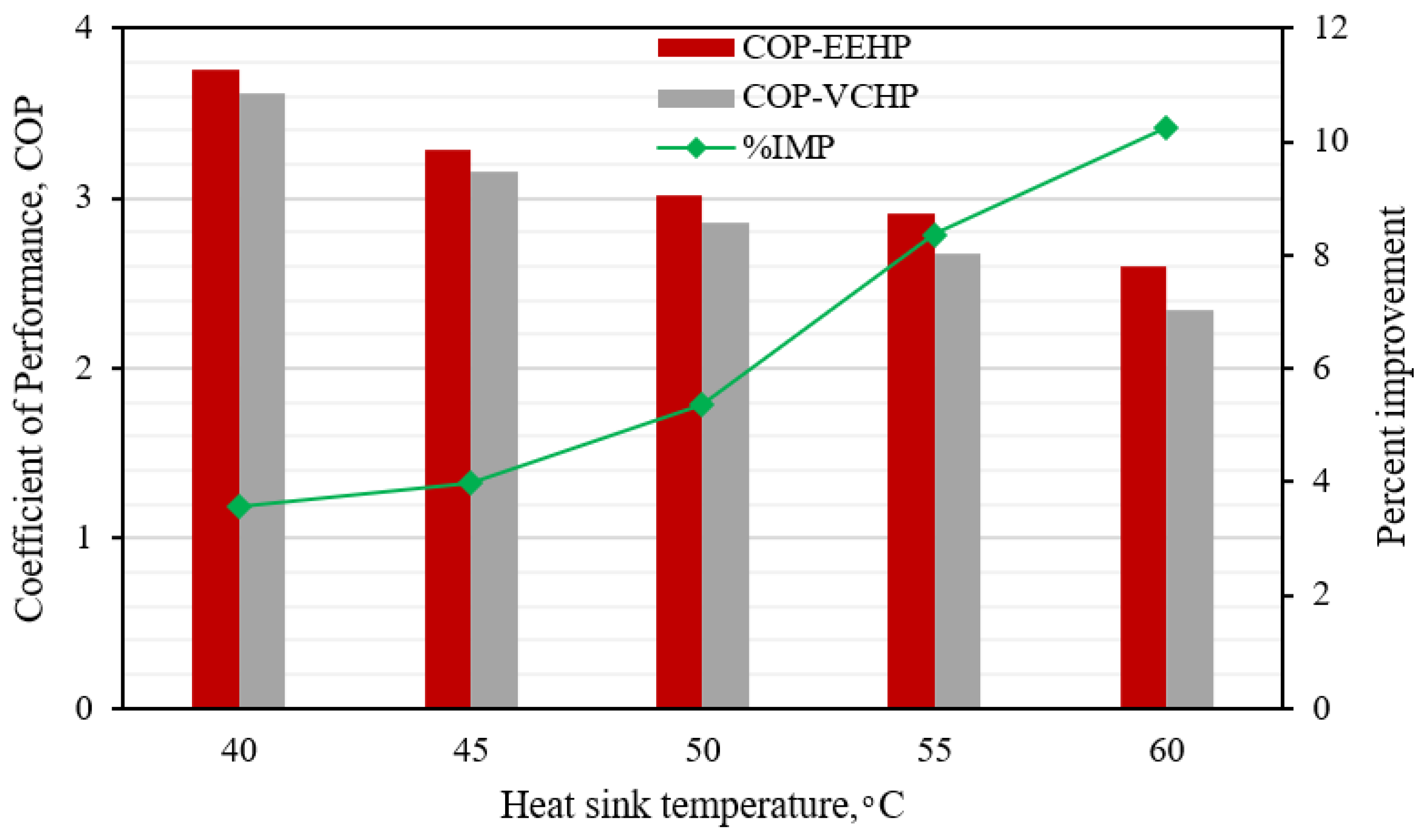

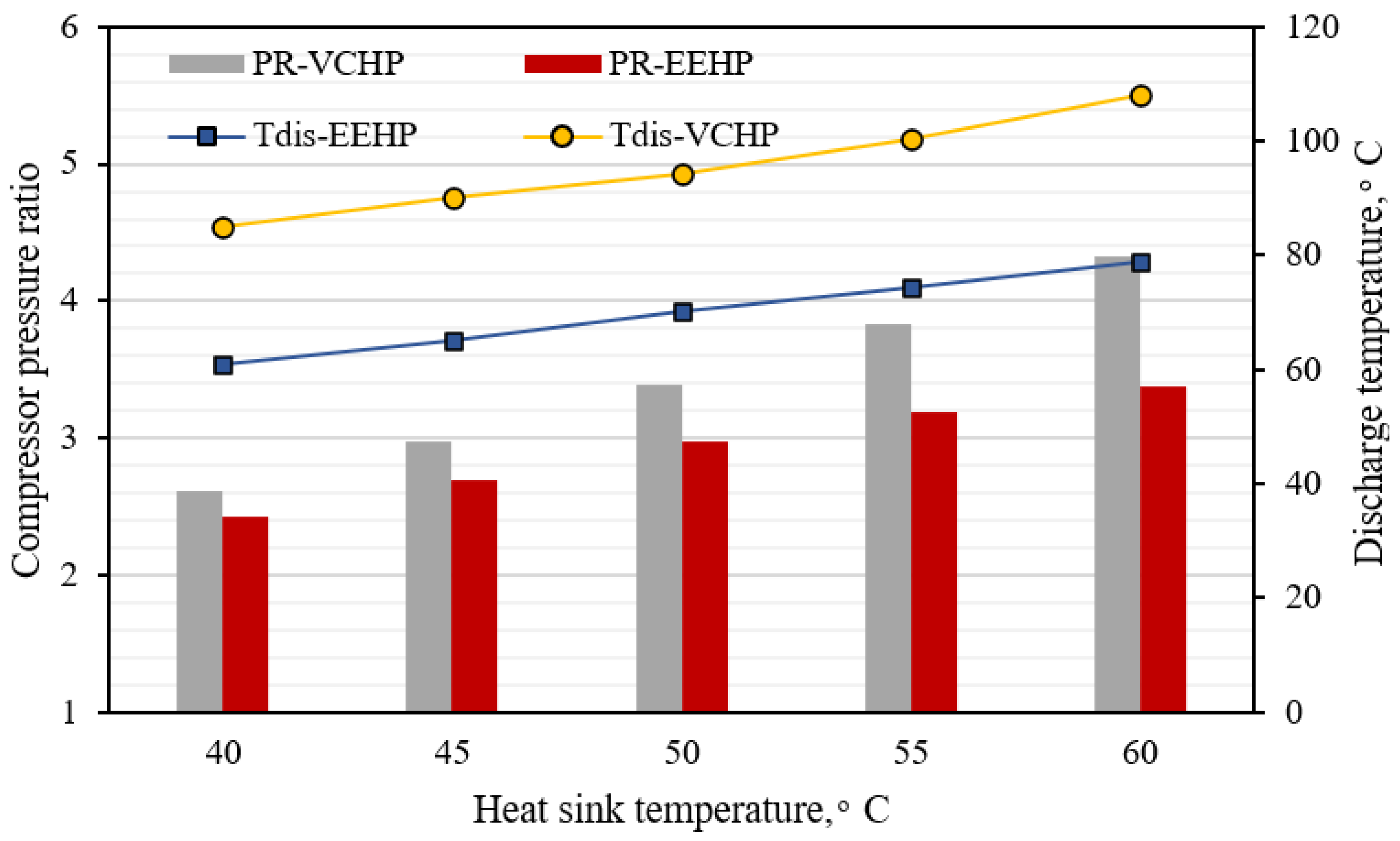





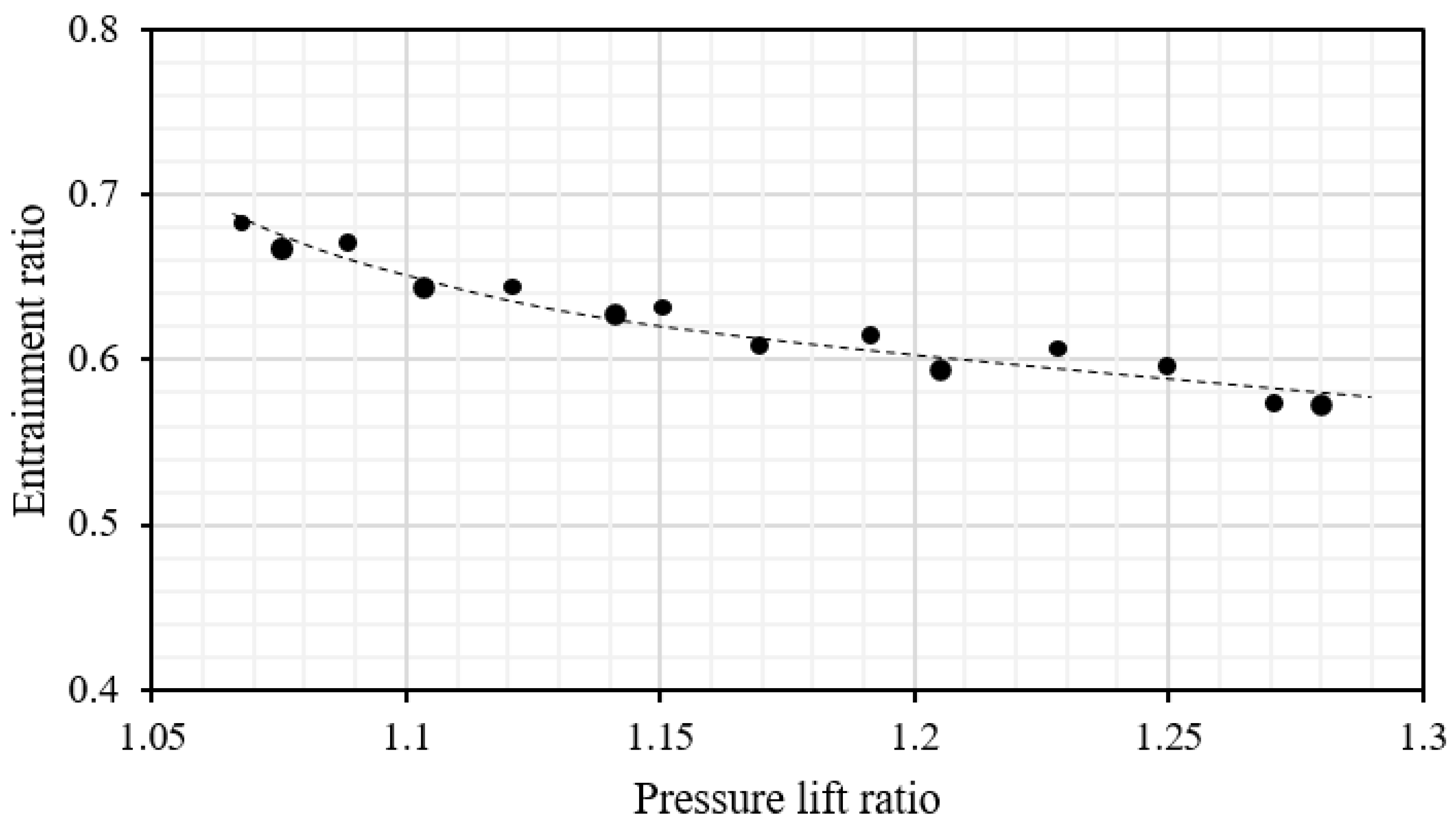
| Item | Uncertainty | Model |
|---|---|---|
| Data acquisition | ±0.15% | Yokogawa GP10-1-E-F/UC20 |
| Power meter | ±0.2% | Hioki PQ3100 |
| Thermocouple | 3.0–5.0% | Type K |
| Pressure transducer | 1.0%FS | Dixell, PF11 |
| Volume flow meter | 3.5–5.0% | Burkert, 8030SE30 |
Disclaimer/Publisher’s Note: The statements, opinions and data contained in all publications are solely those of the individual author(s) and contributor(s) and not of MDPI and/or the editor(s). MDPI and/or the editor(s) disclaim responsibility for any injury to people or property resulting from any ideas, methods, instructions or products referred to in the content. |
© 2023 by the authors. Licensee MDPI, Basel, Switzerland. This article is an open access article distributed under the terms and conditions of the Creative Commons Attribution (CC BY) license (https://creativecommons.org/licenses/by/4.0/).
Share and Cite
Singmai, W.; Onthong, K.; Thongtip, T. Experimental Investigation of the Improvement Potential of a Heat Pump Equipped with a Two-Phase Ejector. Energies 2023, 16, 5889. https://doi.org/10.3390/en16165889
Singmai W, Onthong K, Thongtip T. Experimental Investigation of the Improvement Potential of a Heat Pump Equipped with a Two-Phase Ejector. Energies. 2023; 16(16):5889. https://doi.org/10.3390/en16165889
Chicago/Turabian StyleSingmai, Wichean, Kasemsil Onthong, and Tongchana Thongtip. 2023. "Experimental Investigation of the Improvement Potential of a Heat Pump Equipped with a Two-Phase Ejector" Energies 16, no. 16: 5889. https://doi.org/10.3390/en16165889





